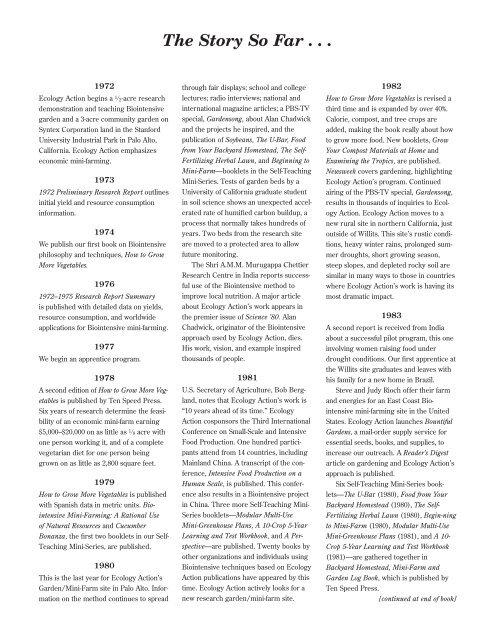How to Grow More Vegetables : And Fruits, Nuts ... - Shroomery
How to Grow More Vegetables : And Fruits, Nuts ... - Shroomery
How to Grow More Vegetables : And Fruits, Nuts ... - Shroomery
You also want an ePaper? Increase the reach of your titles
YUMPU automatically turns print PDFs into web optimized ePapers that Google loves.
1972<br />
Ecology Action begins a 1 ⁄ 2-acre research<br />
demonstration and teaching Biointensive<br />
garden and a 3-acre community garden on<br />
Syntex Corporation land in the Stanford<br />
University Industrial Park in Palo Al<strong>to</strong>,<br />
California. Ecology Action emphasizes<br />
economic mini-farming.<br />
1973<br />
1972 Preliminary Research Report outlines<br />
initial yield and resource consumption<br />
information.<br />
1974<br />
We publish our first book on Biointensive<br />
philosophy and techniques, <strong>How</strong> <strong>to</strong> <strong>Grow</strong><br />
<strong>More</strong> <strong>Vegetables</strong>.<br />
1976<br />
1972–1975 Research Report Summary<br />
is published with detailed data on yields,<br />
resource consumption, and worldwide<br />
applications for Biointensive mini-farming.<br />
1977<br />
We begin an apprentice program.<br />
1978<br />
A second edition of <strong>How</strong> <strong>to</strong> <strong>Grow</strong> <strong>More</strong> <strong>Vegetables</strong><br />
is published by Ten Speed Press.<br />
Six years of research determine the feasibility<br />
of an economic mini-farm earning<br />
$5,000–$20,000 on as little as 1 ⁄ 8 acre with<br />
one person working it, and of a complete<br />
vegetarian diet for one person being<br />
grown on as little as 2,800 square feet.<br />
1979<br />
<strong>How</strong> <strong>to</strong> <strong>Grow</strong> <strong>More</strong> <strong>Vegetables</strong> is published<br />
with Spanish data in metric units. Biointensive<br />
Mini-Farming: A Rational Use<br />
of Natural Resources and Cucumber<br />
Bonanza, the first two booklets in our Self-<br />
Teaching Mini-Series, are published.<br />
1980<br />
This is the last year for Ecology Action’s<br />
Garden/Mini-Farm site in Palo Al<strong>to</strong>. Information<br />
on the method continues <strong>to</strong> spread<br />
The S<strong>to</strong>ry So Far . . .<br />
through fair displays; school and college<br />
lectures; radio interviews; national and<br />
international magazine articles; a PBS-TV<br />
special, Gardensong, about Alan Chadwick<br />
and the projects he inspired, and the<br />
publication of Soybeans, The U-Bar, Food<br />
from Your Backyard Homestead, The Self-<br />
Fertilizing Herbal Lawn, and Beginning <strong>to</strong><br />
Mini-Farm—booklets in the Self-Teaching<br />
Mini-Series. Tests of garden beds by a<br />
University of California graduate student<br />
in soil science shows an unexpected accelerated<br />
rate of humified carbon buildup, a<br />
process that normally takes hundreds of<br />
years. Two beds from the research site<br />
are moved <strong>to</strong> a protected area <strong>to</strong> allow<br />
future moni<strong>to</strong>ring.<br />
The Shri A.M.M. Murugappa Chettier<br />
Research Centre in India reports successful<br />
use of the Biointensive method <strong>to</strong><br />
improve local nutrition. A major article<br />
about Ecology Action’s work appears in<br />
the premier issue of Science ’80. Alan<br />
Chadwick, origina<strong>to</strong>r of the Biointensive<br />
approach used by Ecology Action, dies.<br />
His work, vision, and example inspired<br />
thousands of people.<br />
1981<br />
U.S. Secretary of Agriculture, Bob Bergland,<br />
notes that Ecology Action’s work is<br />
“10 years ahead of its time.” Ecology<br />
Action cosponsors the Third International<br />
Conference on Small-Scale and Intensive<br />
Food Production. One hundred participants<br />
attend from 14 countries, including<br />
Mainland China. A transcript of the conference,<br />
Intensive Food Production on a<br />
Human Scale, is published. This conference<br />
also results in a Biointensive project<br />
in China. Three more Self-Teaching Mini-<br />
Series booklets—Modular Multi-Use<br />
Mini-Greenhouse Plans, A 10-Crop 5-Year<br />
Learning and Test Workbook, and A Perspective—are<br />
published. Twenty books by<br />
other organizations and individuals using<br />
Biointensive techniques based on Ecology<br />
Action publications have appeared by this<br />
time. Ecology Action actively looks for a<br />
new research garden/mini-farm site.<br />
1982<br />
<strong>How</strong> <strong>to</strong> <strong>Grow</strong> <strong>More</strong> <strong>Vegetables</strong> is revised a<br />
third time and is expanded by over 40%.<br />
Calorie, compost, and tree crops are<br />
added, making the book really about how<br />
<strong>to</strong> grow more food. New booklets, <strong>Grow</strong><br />
Your Compost Materials at Home and<br />
Examining the Tropics, are published.<br />
Newsweek covers gardening, highlighting<br />
Ecology Action’s program. Continued<br />
airing of the PBS-TV special, Gardensong,<br />
results in thousands of inquiries <strong>to</strong> Ecology<br />
Action. Ecology Action moves <strong>to</strong> a<br />
new rural site in northern California, just<br />
outside of Willits. This site’s rustic conditions,<br />
heavy winter rains, prolonged summer<br />
droughts, short growing season,<br />
steep slopes, and depleted rocky soil are<br />
similar in many ways <strong>to</strong> those in countries<br />
where Ecology Action’s work is having its<br />
most dramatic impact.<br />
1983<br />
A second report is received from India<br />
about a successful pilot program, this one<br />
involving women raising food under<br />
drought conditions. Our first apprentice at<br />
the Willits site graduates and leaves with<br />
his family for a new home in Brazil.<br />
Steve and Judy Rioch offer their farm<br />
and energies for an East Coast Biointensive<br />
mini-farming site in the United<br />
States. Ecology Action launches Bountiful<br />
Gardens, a mail-order supply service for<br />
essential seeds, books, and supplies, <strong>to</strong><br />
increase our outreach. A Reader’s Digest<br />
article on gardening and Ecology Action’s<br />
approach is published.<br />
Six Self-Teaching Mini-Series booklets—The<br />
U-Bar (1980), Food from Your<br />
Backyard Homestead (1980), The Self-<br />
Fertilizing Herbal Lawn (1980), Begin-ning<br />
<strong>to</strong> Mini-Farm (1980), Modular Multi-Use<br />
Mini-Greenhouse Plans (1981), and A 10-<br />
Crop 5-Year Learning and Test Workbook<br />
(1981)—are gathered <strong>to</strong>gether in<br />
Backyard Homestead, Mini-Farm and<br />
Garden Log Book, which is published by<br />
Ten Speed Press.<br />
[continued at end of book]












